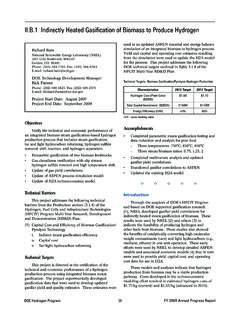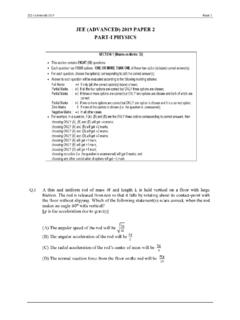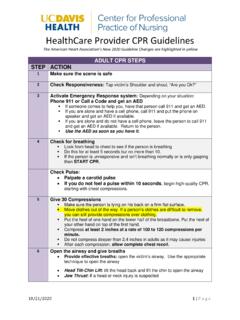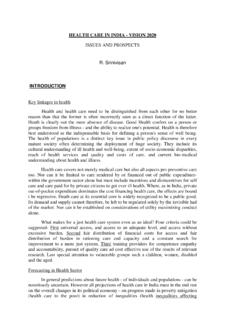Transcription of High Efficiency PEM Water Electrolysis Enabled by Advanced …
1 High Efficiency PEM Water Electrolysis Enabled by Advanced Catalysts, Membranes and ProcessesPI: Dr. Katherine AyersNel HydrogenMay 20, 2020 Project ID # P155 This presentation does not contain any proprietary, confidential, or otherwise restricted informationHydroGEN: Advanced Water Splitting Materials2 High Efficiency PEM Water ElectrolysisKathy Ayers, Nel HydrogenIryna Zenyuk, University of California, IrvineKarren More, ORNLWe are solving the cost barriers for PEM Electrolysis by integrating Advanced cell designs and materials supported by fundamental characterizationProject VisionThe anticipated impact of incorporating all elements of the Advanced membrane, catalyst, electrode fabrication techniques, and cell modeling is to realize a reliable MEA configuration with Efficiency meeting the 43 kWh/kg targetsProject ImpactProject OverviewExample of tomography and colored liquid Water imageAward#EE0008081 StartDateProject End Date9/1/20178/31/2020 Total DOE ShareCurrent BP ShareTotal Cost Share$ $387K$.
2 Advanced Water Splitting Materials3 Approach-SummaryProject historyThinner membranes and alternate catalysts have shown promise for stable operation of PEM electrolyzersat improved Efficiency . This project advances material performance and integrates components together, while leveraging fundamental characterization to understand and push design targetsPartnershipsIryna Zenyuk, UCI: In situ tomography to characterize CLs, PTLs, and Water distributionDavid Cullen, ORNL: TEM of platinum group metal migrationBarriers Long term durability: understand degradation through accelerated tests and fundamental characterization Higher defect sensitivity with adv. materials and operation: refine cell design and characterize in situMetricStateof the ArtProposedMembrane thickness175 microns50 micronsOperating temperature58 C80-90 CCell Efficiency53 kWh/kg43 kWh/kgHydroGEN: Advanced Water Splitting Materials4 Approach-Innovation PEM Electrolysis has the potential for significant Efficiency improvement challenge is integrating and extending what we know, where complex interactions exist Holistic view of problem including interaction with EMN nodes Understanding of catalyst dissolution and membrane hydration to support formulations and methods of manufacture Porous substrates: understanding and improving uneven distribution, coatings Impact of deposition methods, synthesis conditions, binders etc.
3 On cell performance and reliabilityHydroGEN: Advanced Water Splitting Materials5 Approach -InnovationHigh Efficiency MEAAdv. AnodeCoating & Optical InspectionDeposition Down-selectAST ProtocolsInk & I:C TuningLow Loading OptimizationPerformance & Durability MembraneCross-over Mitigation DevPerformance & Durability EvalAST ProtocolsCell Tuning for Thin MembraneCL & PTL ModelingMechancialTestingIn-operando X-Ray TomographyAdv. CathodeCoating & Optical InspectionDeposition Method Down-selectAST ProtocolsInk &I:C TuningLow Loading OptimizationPerformance & Durability of GDEGDEPEMIn-situ imaging shows catalyst as highlighted featuresHydroGEN: Advanced Water Splitting Materials6 Relevance & Impact PEM Water Electrolysis has significant development opportunities for increased electrical Efficiency , without sacrifice in durability through: Integration of membranes 50 m thick, capable of 80-90 oCoperation, while controlling mechanical creep and gas crossover Reducing the catalyst loading by at least 1/10thon both electrodes, while controlling Water distribution and the PTL/CL electrochemical interface Synthesis of higher activity OER catalysts and refinement of electrode fabrication process Integration of these characteristics into a full MEA Supporting National Labs and subcontractors will assist in characterizing materials and process modification Accomplished through material characterization, in-operando analysis, and Advanced modeling of membrane and PTL interactions Final deliverable of the project will be an Advanced Electrolysis stack producing H2at 43 kWh/kg and at costs of $2/kg H2 HydroGEN: Advanced Water Splitting Materials7 Accomplishments.
4 Budget Period 2 Quarterly MilestonesBP 2 (12 months) MilestonesQuarterBPCompletionDemonstrate 500 hrdurability using steady state or AST of target Advanced MEA at > 80 oCcompared to baseline8 *(go/no go)2100%Downselectcrossover mitigation using operational data and TEM characterization. H2 recombination effectiveness should be >75%93100%Ex-situ and in-operando data are fed into deterministic contact mechanics model. The results are delivered to LBNL for cell performance modeling103100%Provide Hydrogen with Advanced MEA for validation based on 500-h durability downselect, as discussed above. Total electrode PGM content will be mg/cm2 with final down-selected hydrogen cross-over mitigation included11 350%Demonstrate activity and 500 hrdurability of Advanced MEA in 3-cell 86 cm2electrolysis stack that meets all the project specific targets 12325%* Q8 milestone was successful and approval given for BP3 extension. HydroGEN: Advanced Water Splitting Materials8 Accomplishments to Date Ex-situ characterization of catalysts by NREL: RDE/ICP for changes in activity resulting from dissolution of OER catalysts Commercially sourced OER catalysts screened Various blends of pure IrOx and IrRuOxtested for stability Down-selected source of pure IrOx from supplier Showed good stability and improved performance over baseline PTL development on-going at NREL Ink and deposition improvements made to address lack of MPL on PTL Early wetting issue being addressed X-ray tomography conducted during Electrolysis operation Sintered particle and fiber PTLs assessed Loadings varied between low (33% of baseline), medium (66% of baseline), and high (baseline) Catalyst coated membrane (CCM) versus gas diffusion electrode (GDE) Assessments made on which configuration provided highest utilizationHydroGEN.
5 Advanced Water Splitting Materials9 Accomplishments to Date 2D model Electrolysis model created and validated through operational data Mechanical testing of membrane samples hydrated at various temperatures in progress Stress/strain curves generated to look at changes in creep characteristics Assessment made of ex-situ and in-situ hydrated membranes Varied thickness, chemistries, and hydration temperature explored ~1400 hours achieved with Advanced OER catalysts and higher Efficiency membrane Voltage shown stable at ~ (~72% LHV Efficiency ), 80 C and A/cm2 Voltage shown stable at ~ (~70% LHV Efficiency ), 80 C and A/cm2 HydroGEN: Advanced Water Splitting Materials10 Accomplishments: Where we are today Crossover Several different methods of hydrogen mitigation have been assessed Initial testing looked at effectiveness on baseline N117 Once process established, transitioned to 50 micron (~2 mil) Optimization of treatment has resulted in a >78% effectiveness at full hydrogen production 88% effect during turndown testingTestMembraneCross-over LayerXover17-milBaselineXover250 mBaselineXover350 m4x loadingHydroGEN: Advanced Water Splitting Materials11 Accomplishments.
6 Where we are today -Testing Operational tests using the down-selected OER catalysts and transition to supported HER catalysts have translated into significant Efficiency improvements Results also capture use of 50 micron membrane HER loading was reduced by 75% versus baseline >70% LHV achieved at baseline current density of A/cm2and 50C 70% LHV Efficiency maintained with increase of 25% in current density to A/cm2and 80C Keeps high Efficiency , while allowing for further CapExreductions HydroGEN: Advanced Water Splitting Materials12 Collaboration Electrolyzer Modeling 2-D MEA cross-section model Hybrid layer approach to simulate contact of solid PTL with catalyst Uniform catalyst film in CCM Discreet particles on top of PTL in PTE Macro-homogeneous, multi-physics model Model shows accurate performance similar to theexperimental results for this cell configuration CCM has better performance due to better connected ionic pathways PTE has catalyst deposited on TiPTL -> Few electrolyte contacts Entire proton flux must be tunneled through few contact points Significant ionic potential loss occurs at the choke pointsCCMPTEH ydroGEN.
7 Advanced Water Splitting Materials13 Creep rate [/hr] - Dry25 5 5 5 5 80 Creep Strain [%]Wet35 MPa35 MPa5 MPa5 80 Creep Strain [%]Dry35 MPa35 MPa5 MPa35 MPa5 MPa Elevated temperature increases creep in dry state Elevated temperature affects creep in wet state, depending on compression Higher creep at high temperature; but rate is lower at higher compression At high temperature, compression levels suppress the creep response Hydration increases creep response at 25 but is negligible at elevated temperatureCollaboration Membrane: Effect of Temperature on CreepHydroGEN: Advanced Water Splitting Materials14 Experiment A: Creep compression with 35 MPa stress held for 24 hours at 25 C (Dry) Thinner membranes creep more in dry stateCollaboration Membrane: Effect of Thickness on Creep Thinner membranes creep less in waterExperiment B: Creep compression with 35 MPa stress held for 24 hours at 25 C (Wet) HydroGEN: Advanced Water Splitting Materials15 Collaboration compression creep of Nafion: Dry vs.
8 Wet Nafion 117 Pretreated membranes Dry state vs. Wet State at 25 C Hold pressure: 5 MPa (725 psi) for 24 hours 35 MPa (5000 psi) for 24 hours Nafion is more resistant to creep in Water . Creep strain: Wet: m/ m Dry: m/ m In Water , Nafion exhibits a stronger dependence on stress ( compression ) level, which results in a bigger change in thickness reduction (due to creep)HydroGEN: Advanced Water Splitting Materials16 Collaboration Catalyst: Evaluating factors of surface area, composition, oxide content, morphology, and crystallinity Understand differences between catalysts Provide explanation for how these differences effect activity/durability Develop understanding of how RDE activity translates to MEA performance, when incorporating Ru and mixed surfaces PTL: Directly coat an iridium oxide ink-based catalyst layer onto a highly porous, sintered titanium substrate Reduce production steps compared to a transfer liner technique Decrease ohmic losses due to low contact quality between PTL and catalyst layer Avoid direct coating of membrane which requires swelling mitigation (difficult in roll to roll manufacturing) HydroGEN.
9 Advanced Water Splitting Materials17020406080100120140160180 ECA [m2gIr-1]Collaboration Catalyst:Surface Area, Metal/Oxide Near-Surface Differences in HUPD, capacitance across material sets. Used to qualitatively separate sources of surface area. Difference to HgUPDdue to mixed oxides; neither HUPD/capacitance are reflective of total composition. Notable separation in HgUPD/BET observed, particularly with multicomponentsand high surface area. May require Ru/Nbconsiderations and lower [mA cmelec 2]E [V vs RHE] [mA cmelec 2]E [V vs RHE] [mA cmelec 2]E [V vs RHE] [mA cmelec 2]E [V vs RHE]Round 2 Round 3 Round 4 Round 5020406080100120140160180 ECA [m2gIr-1]HUPDC apacitanceHgUPDBETH ydroGEN: Advanced Water Splitting Materials18203040506070802 [ ]Collaboration Catalyst:Morphology, CrystallinityRound 2 Round 3 Round 4 Round 5 Material differences in relative surface roughness, aggregate size For catalysts with high porosity, large aggregates, may be difference between electrolyte/gas site access Catalysts relatively crystalline, indicate mixture of metal/rutile in bulk Translation of surface composition to the bulk.
10 Example: Rd 3 and 4 primarily participate in HUPD, metal 2 Round 3 Round 4 Round 5 IrIrO2 HydroGEN: Advanced Water Splitting Materials19 A series of ink solvent system experiments were performed to test wettability on the PTL substrate and to determine the best system for a uniform coating An ink based on a 1:20 nPA:glycerolmixture was rod coated and successfully produced uniform coatings Three 1:20 nPA:glycerolbased ink rod coated samples were sent to Nel for performance testing The project goal was achieved in that catalyst layers were successfully coated directly onto PTL substrates. Unfortunately, their performance was not as good as the catalyst coated membrane architecture. Final test samples sent to Nel for performance testingCollaboration PTL DevelopmentWetting comparison. Left to right: 1:1, 1:3, 1:10, 1:30 (nPA: glycerol)Diagram of Rod coatingHydroGEN: Advanced Water Splitting Materials20 In-depth characterization of morphology of sintered and fiber PTLs: Sintered Tihas more uniform in-plane porosity but lower than Tifiber Tifiber has a greater porosity compared to the sintered partSinteredFiberSinteredFiberSinteredFi berCollaboration Ex-situ Morphology: PTL Sintered vs.















